This incredibly easy and flavorful Thai Salmon Curry is made with tender, flaky salmon and crunchy vegetables in a creamy sauce of coconut milk and umami-packed red curry paste.
Using this quick Instant Pot or stovetop recipe, this gluten-free dish will be on your table in under 30 minutes!
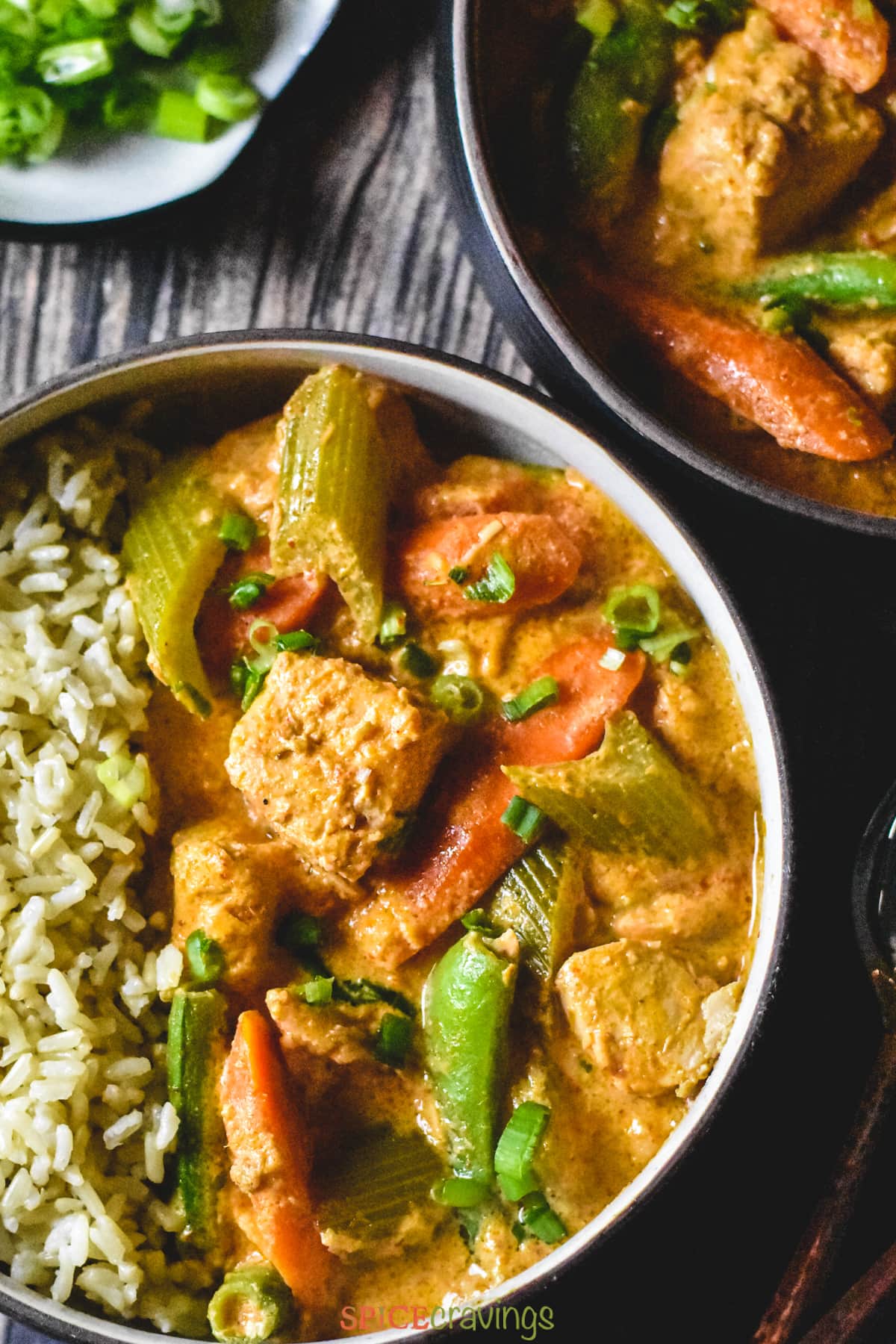
This red curry recipe is one of my go-to weeknight meals. It's wholesome, satisfying, and comes together in a flash using a handful of ingredients from my pantry and refrigerator.
It's a pretty versatile recipe that can be made with the protein of your choice - chicken, shrimp, or tofu (vegan).
I serve it with steamed Jasmine rice, and in just 30 minutes, a healthy and hearty meal is ready for my family to enjoy!
More Salmon recipes for you: Healthy Salmon Patties and Tandoori Salmon
Jump to:
Ingredients - Notes & Substitutions
You just need a handful of ingredients in addition to salmon to make this delicious Thai curry. Here's what you need:
Salmon: Wild Alaskan Salmon is my preference. And the best place to buy it is your local fish market. Costco also sells high-quality wild salmon, either fresh or frozen. If purchasing frozen, thaw it in the refrigerator overnight and pat dry before cooking.
Time-Saving Tip: To save time and effort, ask your fishmonger to cut the fillet into 1- 1½ pieces.
Curry Paste: I use Maesri brand red curry paste. It's 100% vegetarian and does not contain any shrimp paste. If you're looking for a certified gluten-free curry paste, Thai Kitchen is another great product line.
Coconut Milk: My tried and trusted brand of coconut milk is Chaokoh. Whichever brand you choose, make sure it is a full-fat version. Give it a good shake before opening.
Vegetables: I use carrot, celery, and snap peas here, but feel free to use any combination of vegetables. Other vegetables that go well include zucchini, peas, and bell peppers.
Fish Sauce: Fish sauce is a pungent, super salty addition that adds a special umami kick. Use soy sauce or gluten-free tamari, depending on your dietary needs.
Finishes: Lime juice and sugar balance the sweet-spicy taste of this curry really well. Use fresh lime for the best taste. As for sweeteners, use coconut palm sugar or regular brown sugar.
How to Make Salmon Thai Curry
Here are the easy step-by-step directions for this Thai red curry with salmon:
Saute curry paste: Turn on Saute and adjust to 'High'. Stir in red curry paste and saute for 30 seconds.
Add coconut milk: Use a whisk and mix it well till the paste is blended with the coconut milk.
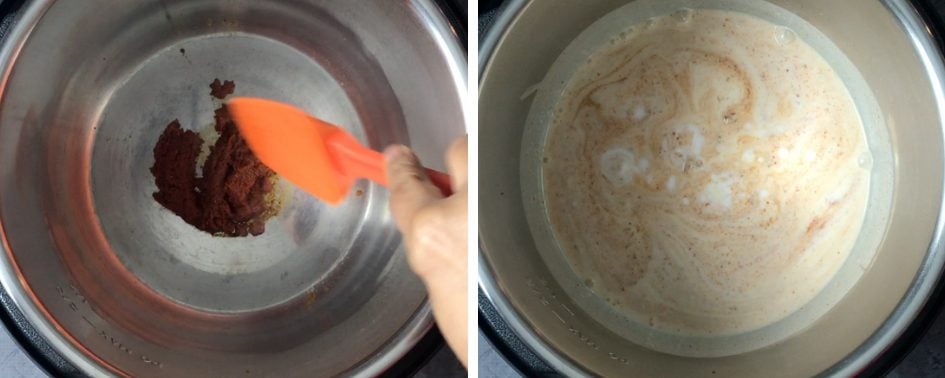
Fish and Vegetables: Add sliced carrots and celery along with salmon chunks, and stir well.
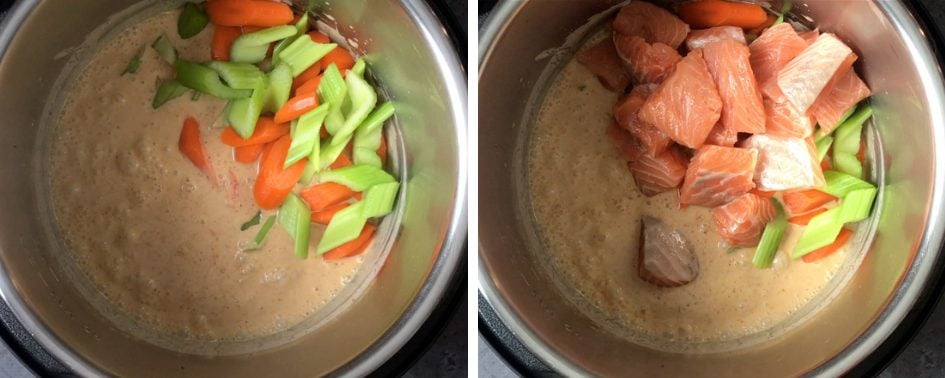
Pressure Cook: As soon as the coconut milk comes to a simmer, cancel saute. Close the lid and pressure cook for 1 minute on low pressure.
Release Pressure: After 5-7 mins of natural pressure release ( NPR), manually release the remaining pressure (QR).
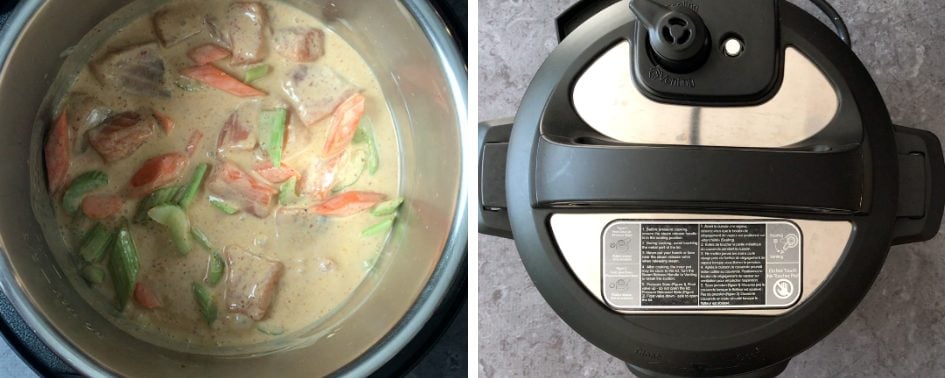
Simmer: Turn on saute. Add brown sugar, lime juice, and sugar snap peas. Simmer for a few minutes until the peas cook to your desired doneness.
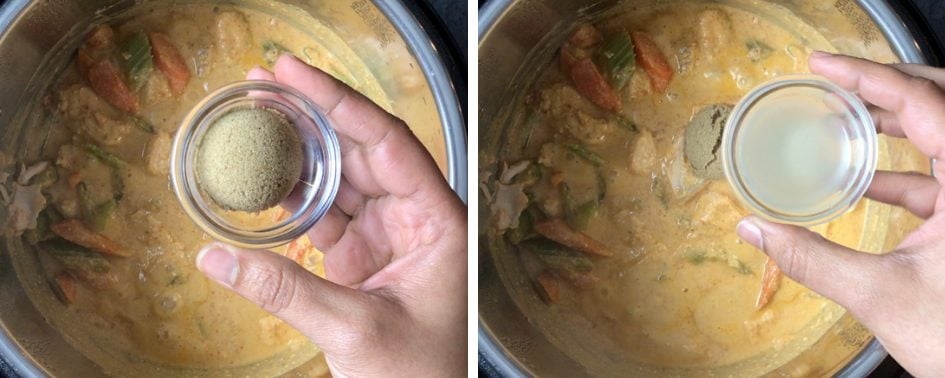
Serve: Enjoy this curry warm over steamed white or brown Jasmine rice.
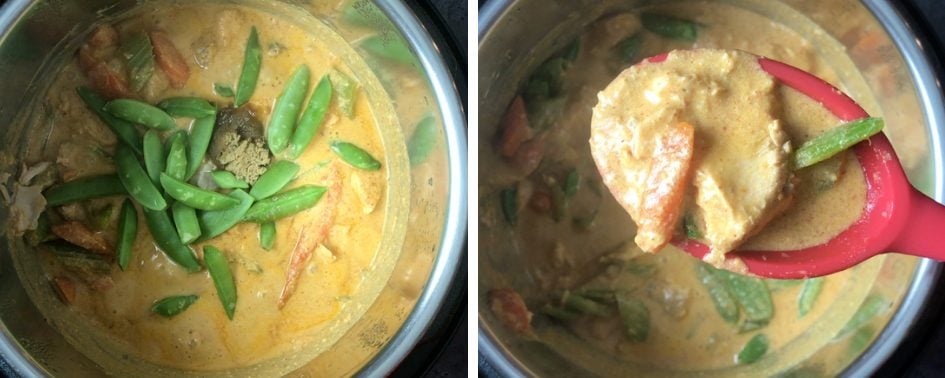
Stovetop Instructions
Make this Thai Curry Salmon on the stove in less than 30 minutes. Simply:
- Heat a dutch oven, or a sauce pot on medium-high heat. When hot, add curry paste and saute for 10 seconds.
- Add coconut milk and whisk it well, till the curry paste blends completely. Add chopped vegetables, salmon pieces and stir.
- Wait for coconut milk to come to a simmer, then reduce heat to medium. Cover the pot and cook for 8-10 minutes, or until the salmon is cooked through.
- Open the lid and add brown sugar, lime juice and sugar snap peas. Saute until snap peas cook to your prefered texture.
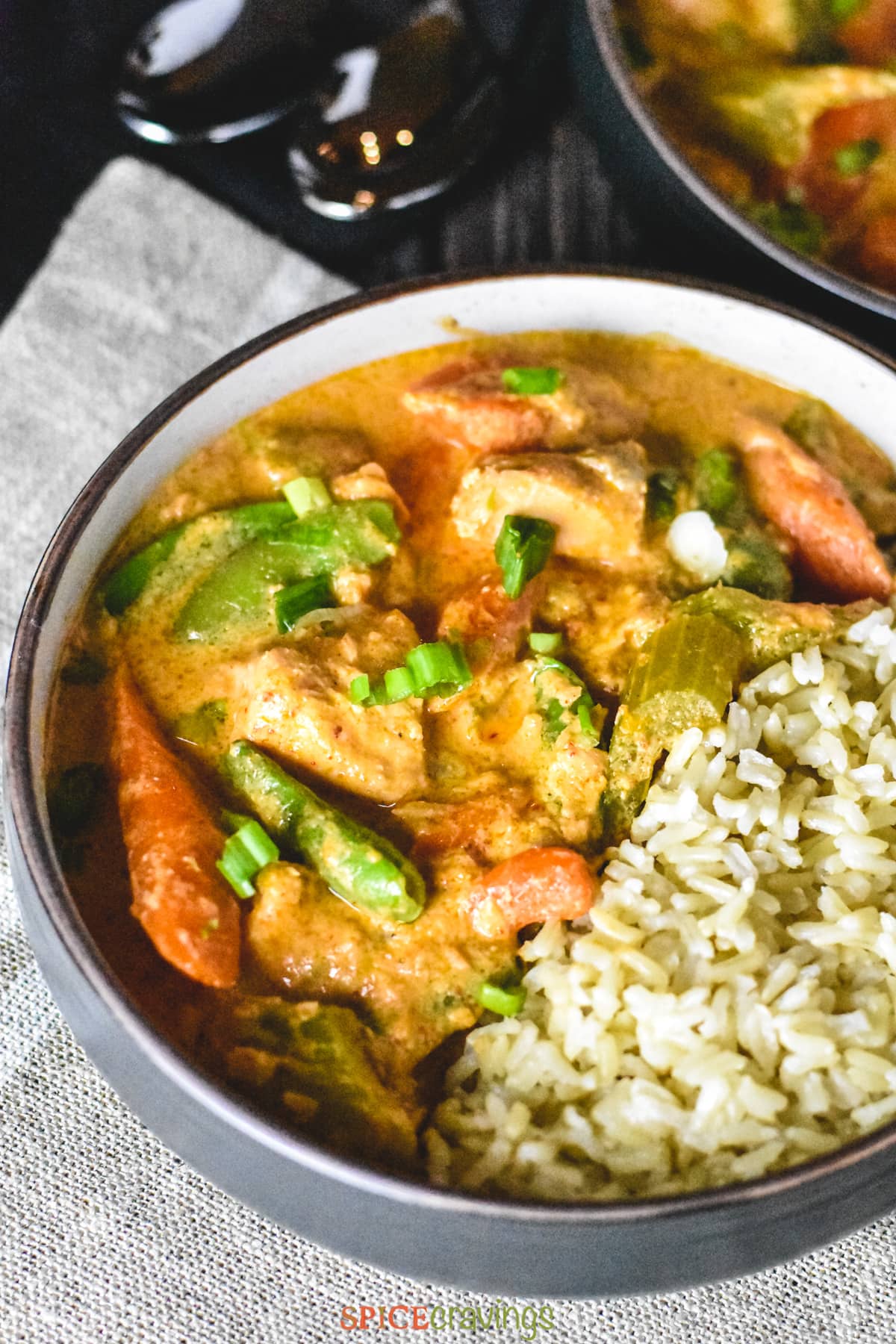
Variations to Try
- Make it with Shrimp Instead: When using shrimp, I add it after pressure cooking and simmer it on saute mode. This prevents overcooking them. Alternatively, you can saute the shrimp before making the curry and then add them back during the final saute stage (step 4).
- Make it with Chicken Instead: I recommend using boneless skinless chicken thighs or breast, cut in 1 inch pieces. Adjust the pressure cooking time to 3 mins, and follow the rest of the recipe.
Serving Suggestions
This salmon curry like most Thai curries pairs well with Jasmine rice, an aromatic and nutty long-grain rice from Thailand. You can serve this curry with white or brown Jasmine Rice. Here are the detailed recipes for both:
Recipe Notes & Tips
- If the coconut milk looks curdled after pressure cooking, turn on Saute and stir it gently for 30-40 seconds, till it becomes smooth again. Sometimes, the fat separates under high pressure, but can be whisked back to normal very easily.
- To make this curry vegetarian, use Extra-firm Tofu or Paneer instead of Salmon. Recipe instructions and timing remain the same.
- When using shrimp instead, I follow the steps for pressure cooking the curry. I add the shrimp after pressure cooking, on Saute mode. This prevents overcooking them. Or saute the shrimp before making the curry and then add them back during the final saute stage.
- When making this curry with with Chicken, use boneless skinless chicken thighs or breast, cut in 1-inch pieces and adjust the pressure cooking time to 4 mins.
Frequently Asked Questions
Absolutely! Place the frozen fillets as-is in the curry and increase the pressure cook time to 3 minutes followed by a quick release.
Yes! You can make this curry with any white-flesh fish as well, like cod, halibut, tilapia, etc.
Salmon is an extremely healthy fish that's rich in omega-3 fatty acids, B vitamins, potassium and selenium, and antioxidants like astaxanthin. It is also high in protein, coming in at 22-25 grams per 3.5 ounces serving.
Popular Thai Curries on the Blog
These recipes are part of the Asian Recipes Collection:
★ Did you make this recipe? Please give it a star rating below! For more quick & easy recipes, FOLLOW ME on Facebook, Instagram, Pinterest and Youtube.
📖 Recipe
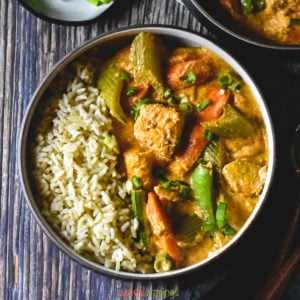
Thai Salmon Curry
Equipment
Ingredients
Pressure Cook
- 1 pound Salmon Filets Cut in 1-1½ inch cubes
- 2 ounce red curry paste (½ of a 4oz. can, add more for deeper flavors and medium-hot heat)
- 13.5 ounce coconut milk (1 can)
- 1 cup celery chopped (about 2-3 ribs)
- 1 cup carrots chopped the same size as celery
After Pressure Cooking
- 1 tablespoon brown sugar or 2 teaspoons honey (adjust to taste)
- 1 teaspoon lime juice adjust to taste
- 1 cup sugar snap peas (or french green beans)
- 2 teaspoons fish sauce or soy sauce
Instructions
Instant Pot Recipe
- Turn on Saute on High. Add red curry paste and saute for 10 seconds. Add coconut milk and mix well till the paste is blended.
- Add sliced carrots, celery and salmon pieces, and stir. Wait for coconut milk to come to a simmer and then cancel saute. Close the lid and select Manual or Pressure Cook and adjust to Low Pressure. Set for 1 minute. Note: If your salmon pieces are larger than 1-1½ inches, adjust time to 2 mins.
- Wait 5-7 mins for natural pressure release and then release the remaining pressure manually.
- Open the lid after the pin drops. Turn ON saute and add brown sugar, lime juice, and sugar snap peas. Simmer for a few minutes or until your desired texture for snap peas. Serve warm with Jasmine rice. Note: When you open the lid and the coconut milk looks curdled, simply stir it gently on saute mode and it becomes smooth again.
Stove-Top Recipe
- Heat a dutch oven, or a sauce pot on medium-high heat. When it gets hot, add curry paste and saute for 10 seconds to wake up the spices.
- Add coconut milk and whisk it well, till the curry paste blends completely. Add chopped vegetables, salmon pieces and stir. Wait for coconut milk to come to a simmer, then reduce heat to medium. Cover the pot and cook for 8-10 minutes, or until the salmon is cooked through.
- Open the lid and add brown sugar, lime juice and sugar snap peas. Saute for 30 seconds, or cook longer if you like your snap peas softer. Serve warm with Jasmine rice.
Video
Notes
- If the coconut milk looks curdled after pressure cooking, turn on Saute and stir it gently for 30-40 seconds, till it becomes smooth again. Sometimes, the fat separates under high pressure, but can be whisked back to normal very easily.
- To make this curry vegetarian, use Extra-firm Tofu or Paneer instead of Salmon. Recipe instructions and timing remain the same.
- When using shrimp instead, I follow the steps for pressure cooking the curry. I add the shrimp after pressure cooking, on Saute mode. This prevents overcooking them. Or saute the shrimp before making the curry and then add them back during the final saute stage.
- When making this curry with with Chicken, use boneless skinless chicken thighs or breast, cut in 1-inch pieces and adjust the pressure cooking time to 4 mins.


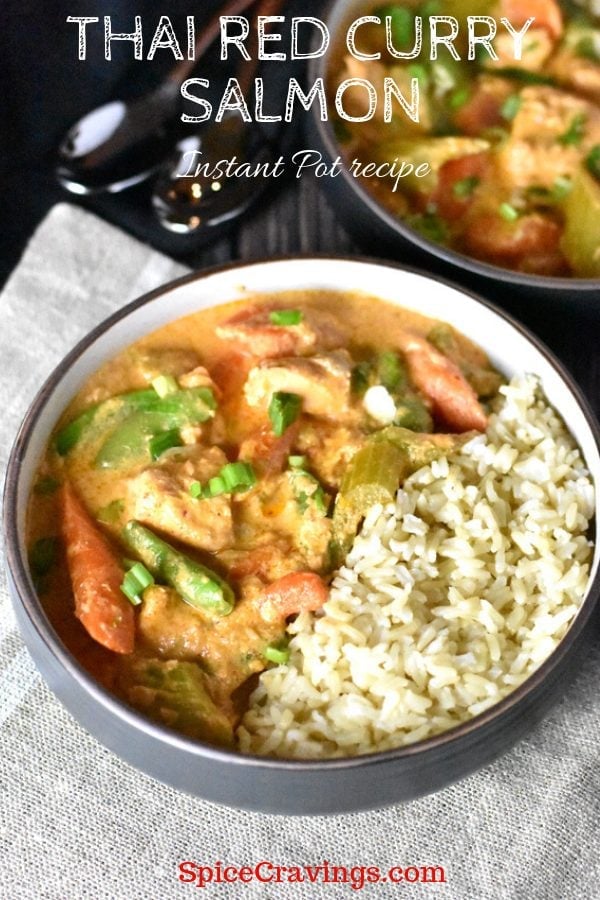
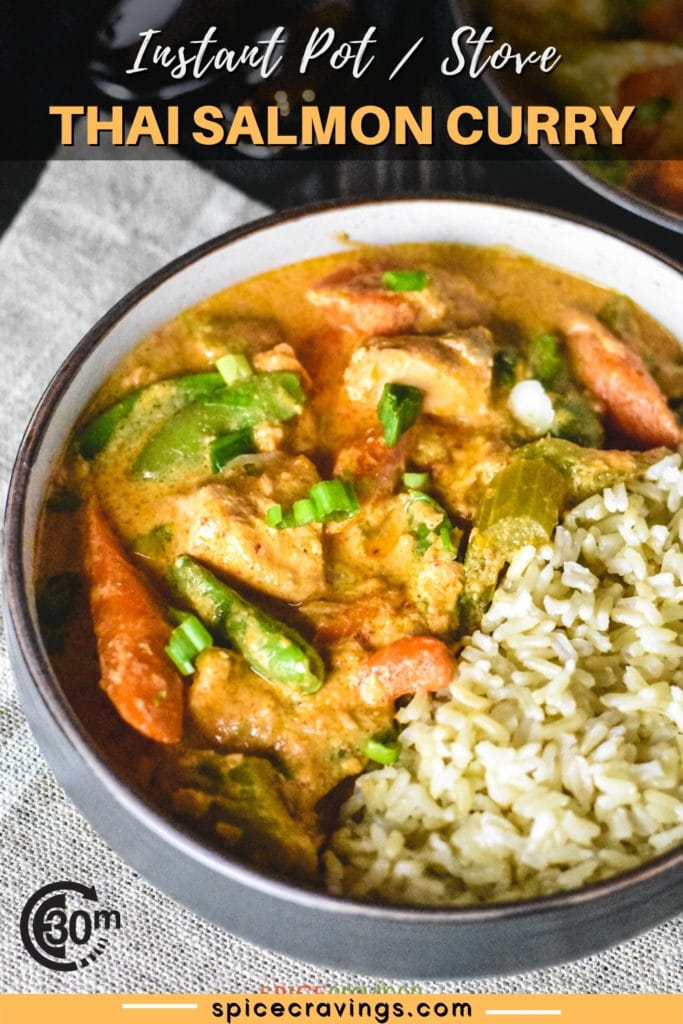
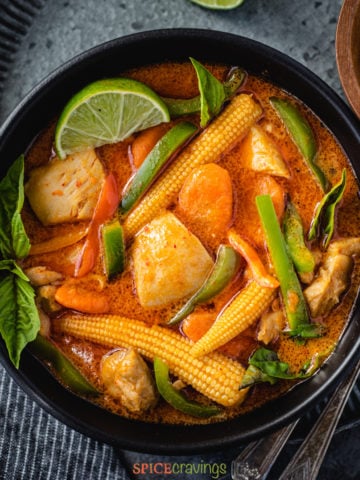
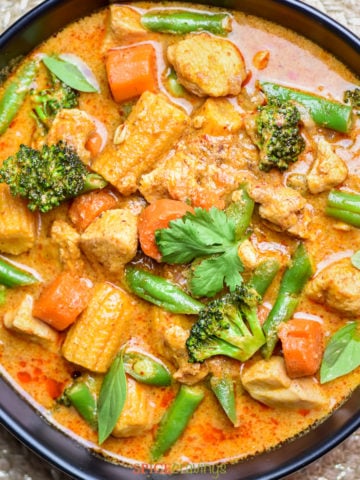
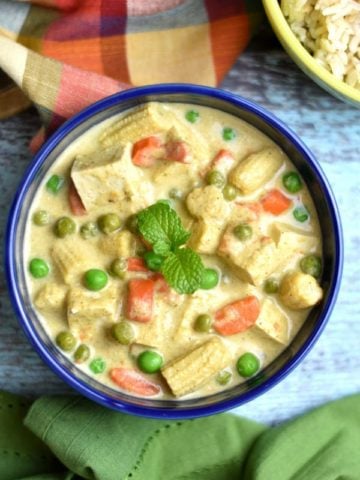
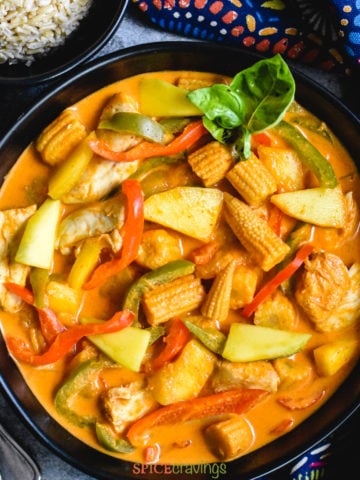
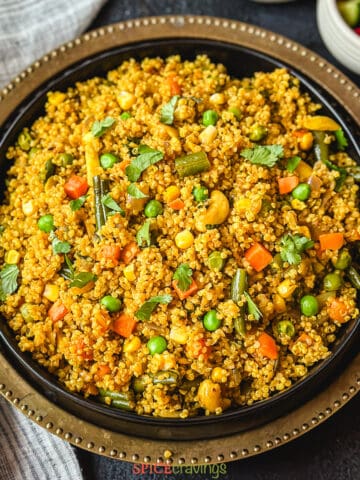
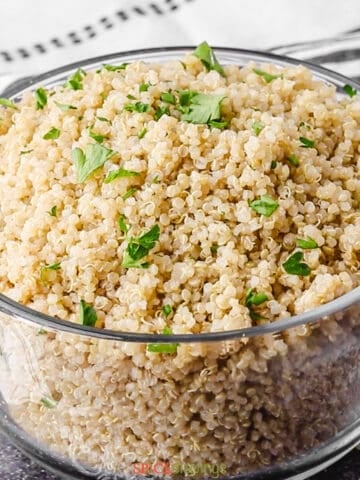
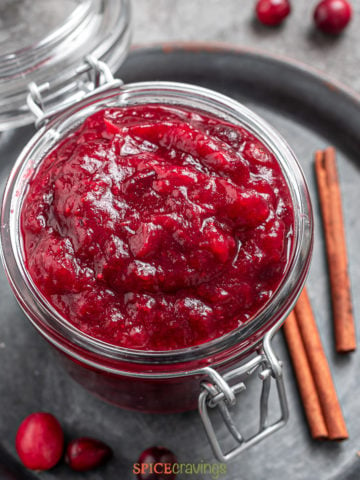
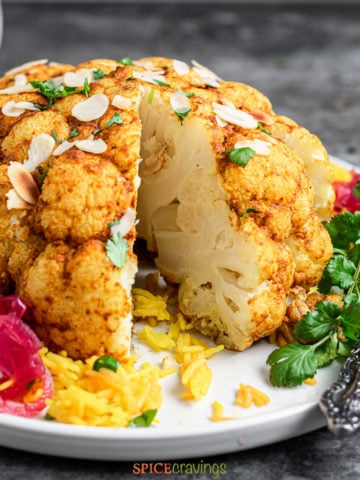

Hutch says
Have you ever done this with frozen salmon? Could I put the frozen salmon right into the instapot (something Ive done with chicken) or better to let it thaw? Thanks!
Aneesha says
Hi Hutch, I haven't tried it with frozen salmon but it should work. If you thaw it then simply follow the same directions, but if using frozen, just add a minute to the pressure cooking time. Enjoy!
Dan says
Hi does the pressure cooking time increase when the quantity increases? I usually cook 2lbs
Aneesha says
Hi Dan, same cooking time will work for 2 lbs. Enjoy!